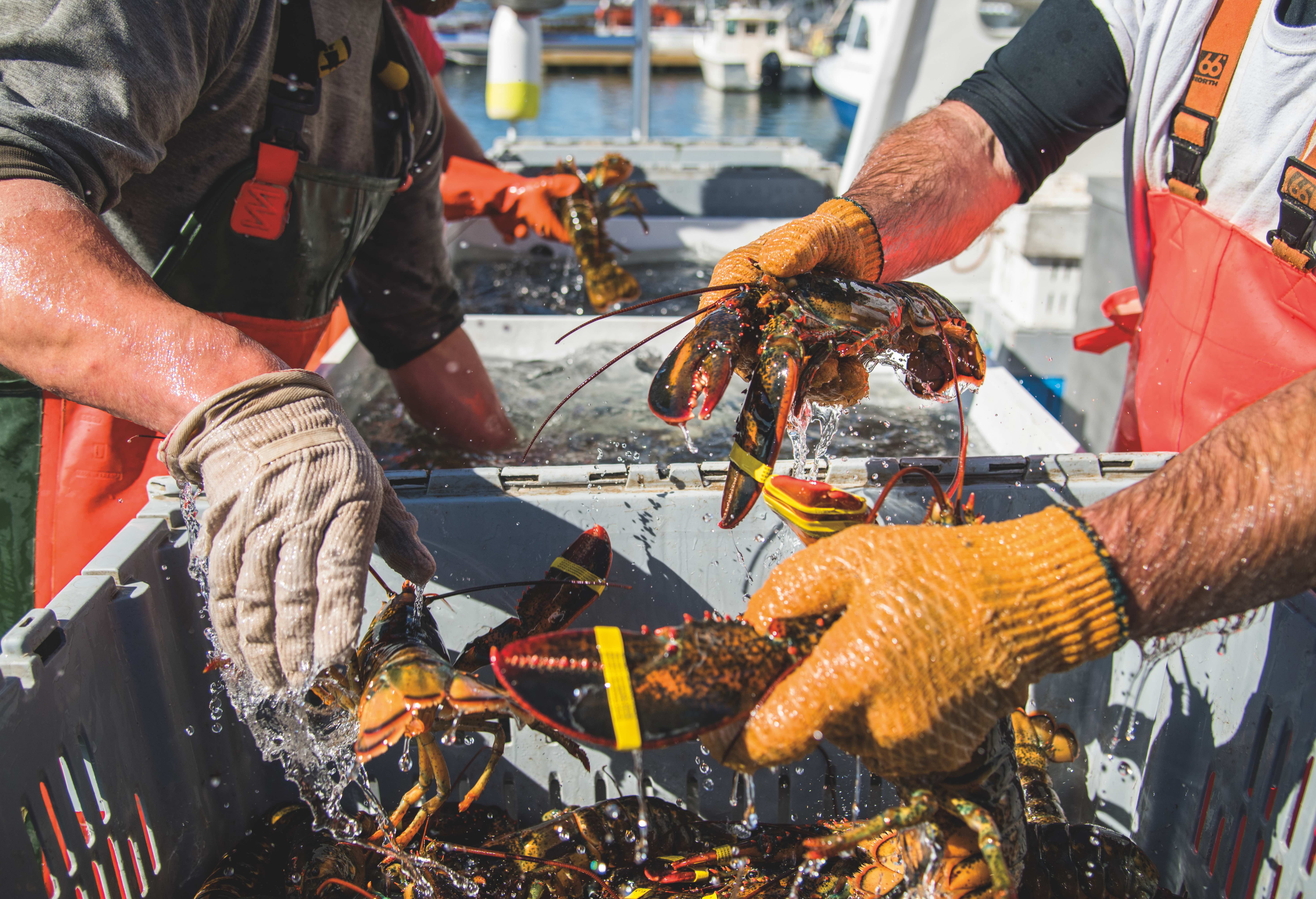
When you go to sea with one of America’s southernmost lobstermen, it’s best to just stay out of the way
By Bill Newcott
Photograph by Jay Fleming
From the April 2023 issue

The lobsters keep their secrets,” says Wes Townsend almost absentmindedly, pointing us straight out to sea, the soft gray glow of a pending sunrise just beginning to define the dark horizon.
It is 4:45 a.m. The good ship Paka has been pushing through 4-foot seas and battling 20 mph winds for the past hour, ever since we emerged from under the Indian River Inlet bridge.
Paka rises and falls rhythmically: Sploosh … sploosh … sploosh. Every once in a while, the hull rides a particularly high wave, hesitates at the crest, then freefalls to the trough: SPLOOSH!
Even now, we’re less than halfway to Townsend’s string of lobster pots, some
30 miles off the coast of Ocean City, Md. As a spectacular ceiling of stars begins to fade, I become increasingly aware of how the horizon rises and falls from view through Paka’s windows. I consider Townsend’s words, and the lobsters’ most significant secret, at least for today: Did enough of them have the misfortune to crawl into those submerged pots to make this trip worthwhile?
Below deck, Townsend’s crew of two — on this day, Dan Iacangelo and Frank Marshall — are curled up in bunks, fast asleep. They headed down there almost as soon as we cleared the inlet. There’s a bunk for me, too, but I’m not sleeping.
I sit in a chair that’s bolted to the deck, across the cabin from Townsend, who steers Paka — a 22-year-old traditional lobster boat — in the general direction of Portugal, his eyes glued to a radar screen that would warn him of any floating obstacles smaller than a container ship.
Townsend knows these waters. A native of Dagsboro — the family farm was deeded in 1735 — he’s been plying them for some 30 years on his own boats, hauling in flounder, sea bass, mackerel, butterfish, scup … and, I was surprised to learn recently, lobster.
In fact, along with one or two small operations out of Ocean City, Townsend is the southernmost professional lobsterman in North America.
The range of the American lobster is, coincidentally, shaped largely like an actual lobster, with its claws pinching at the underbelly of Canada’s Maritime Provinces and its long tail flopping against the Outer Banks of North Carolina.
To our north, thousands of profes-sionals haul in 135 million pounds of lobster each year. Maine and Massachusetts alone account for 93 percent of all American lobsters caught. (To be clear, we’re talking here about classic, two-clawed, fat-tailed northern lobsters — not those weird, scrawny things euph-emistically called Florida lobsters, which are not lobsters at all but glorified shrimp.)
Far below Paka’s hull, the lobsters are on the move. In spring and summer they prefer relatively shallow, warmer water (“shallow” being a relative term; today we’ll be pulling in pots from more than 100 feet down).
“In the winter, they head for the deep,” Townsend says, “into the canyons, 1,000 feet or more down.”
Most of them, anyway. There are wandering lobsters and there are also, as this waterman describes them, “resident lobsters.”
“You can tell the difference by looking at their arms,” he tells me. “The ones that have been moving around have scraped-up arms from crawling around so much.”
Only a true lobsterman, I reason, would ever think to check out the elbows of his catch.
How far does a lobster travel in its life? No one knows. “You’d have to ask a lobster,” Townsend says. “You can tag a fish or a shark to follow its movements, but lobsters molt. Even if you were to put a tag on one, they’d shed it before the information could do you any good.”
A bit over two hours out to sea, with the sun just now peeking over the horizon, the captain ducks his head toward the open doorway beyond which Iacangelo and Marshall are still fast asleep.
“Wakey wakey!” he yells. The pair don’t even rub their eyes — they leap to their feet and bound up the steps. Then begins an intricately choreographed routine as the three prepare the deck for unknown numbers of fish and lobsters.
I start to wander out to join them, bracing myself in the cabin doorway. Townsend takes the measure of my sea legs, then issues what is, most likely, his most important instruction of the day.
“Right,” he says. “See that valve handle right there?” He points to a lever, mounted on a shelf just outside the doorway. It sits at a point where an unsteady landlubber’s hands might go flying for support in an unexpected swell.
“While we’re moving, try not to hit that,” he says, and there is a slight tone of pleading in this voice. “That’s our steerer. Touch that while we’re moving, and it’ll throw us all to the floor.”
I recall the words of Bill Murray in “Ghostbusters”: “Right. That’s bad. Important safety tip. Thanks, Egon.”
Over an 8-mile swath of Atlantic Ocean waters, Townsend maintains about 700 lobster pots — which are not pots at all, but cages with narrow entryways called vents. Each vent is designed for ease of ingress but extremely difficult egress. You’d have to be some kind of Einsteinian crustacean to figure your way out of there and, thankfully, lobsters just aren’t very smart.
The pots, lying on the sea bed, are linked together by rope in groups of 20 — called sets — with floating buoys at each end. The sets are generally oriented north-south, with the northern buoy colored white (“for snow”) and the southern one red (“for sun”).
Today we will be visiting exactly 400 lobster pots, meaning we’ll be making 20 stops. (From 3 to 200 miles offshore, federal regulations set maximums on the number of traps that can be used, based on where among various management areas a boat operates. Within 3 miles of shore, state regulations apply.)Until this moment, Townsend has been wearing street clothes: gray sweat pants and an orange T-shirt. Now, with one hand holding the ship’s wheel, he uses the other to pull on a pair of yellow rubberized overalls. Iacangelo and Marshall are out on deck, doing the same.
Out of nowhere, the spindly top of a buoy appears on Paka’s starboard side. Townsend uses GPS devices to locate his sets, but I get the definite sense he could find these things with his eyes closed. Normal wind and waves can move a pot set a few thousand feet; Hurricane Sandy displaced many of Townsend’s 3 miles.
“At first we were missing 2,000 pots after Sandy,” he recalls. “That was scary. But we kept looking, and in the end we only lost 400. I consider that pretty good.”
It’s time to get to work. As I stand a few inches inside the cabin doorway, Townsend sizes me up one more time.
“OK,” he says. “The one other thing I will say today is that as long as you’re standing, like, right in here — yeah, you’re perfectly safe.”
He sighs, turns toward the open water, and with a silent signal begins conducting what can only be described as a fisherman’s ballet.
From his position on the starboard side, just behind the cabin, Townsend uses a hook to pull the white-topped buoy aboard. Then, in one smooth move, he threads the buoy’s thick rope into a rapidly spinning pulley that draws the line onto the deck at an alarming speed.
Wearing heavy work gloves, Townsend keeps his right thumb and forefinger pinched around the speeding rope, peeling off sea scum that has collected on it since his last visit.
In just a few seconds, the first pot breaks through the surface. Townsend throws the pulley into neutral and hauls the pot onto a flat countertop that traces the entire perimeter of Paka’s deck. Like a TSA officer inspecting the weirdest luggage ever, he slides the pot along to Marshall, who pops open one side of the cage.
For me, anyway, Pot No. 1 is a disappointment. No lobsters to be found; just a few flopping black sea bass. Marshall pulls them from the cage, measures each one on a calibrated wooden board, then tosses the legal ones into a waiting green plastic laundry basket. Then he pushes the pot on to Iacangelo, who guides it all the way around the shelf to the opposite side.
When this 20-pot rig is finished, the empty baskets — still linked by rope — will extend all the way around the deck: Seven on the port side, six on the back, and seven on starboard.
By the time Marshall has pushed Pot No. 1 aside, Townsend has already hauled Pot No. 2 aboard. This one has two unlucky lobsters inside — along with more fish. After taking care of those sea bass, Marshall tugs out a lobster, being careful not to injure the claws that are clinging for dear life to the wire cage.
A cigarette hanging from his mouth, Marshall examines the bottom of each lobster’s tail to make sure it isn’t carrying eggs — if it is, by law he has to throw it back. After a lobster has passed the egg test, Marshall nonchalantly uses a plier-like device to wrap rubber bands around those claws — to keep the lobsters from injuring each other after they, too, are tossed into green plastic laundry baskets.
“You want to try?” Marshall asks me, waving the pliers in my direction. I shake my head and take one step back into the shadows.
While full fish baskets are unceremoniously dumped into a large ice-filled bin at the center of the deck, Iacangelo gingerly places the lobsters, one at a time, in ice-filled coolers, lining them up side by side.
The pots come aboard with alarming frequency — not more than 40 seconds between each arrival. There are, happily, more lobsters and lots more fish. I can’t help but notice that while there is distinct jubilation when a lobster-heavy pot is unloaded, no one says a word when an empty one turns up.
“Every boat has its own system,” Townsend tells me. “This one works for us.”
I should mention that this intricate assembly line operation clicks along while Paka is heaving up and down on those 4-foot seas, which are showing no signs of flattening out, even a little bit. Gingerly, I venture onto the deck to snap a photo of those lobsters in their cooler. As I head back to the safety of the cabin, an unexpected swell sends me pitching forward — directly toward, I’m sorry to say, that very lever Townsend warned me about.
I regain my balance, grab the door frame, and pull myself back into the cocoon where I can do neither myself nor my shipmates any harm. I resist the temptation to glance back at Townsend. He’s still busy with that speeding rope, but I have no doubt he knows precisely what’s happening on Paka at all times, whether he’s looking or not.
Fifteen minutes or so after our arrival at Set No. 1, 20 empty pots sit on the shelf. Townsend hits the engine, and as Paka lurches forward, Iacangelo pushes each pot overboard, setting the line for another try. (Most traps are unbaited on this day, and the few that are baited turn up no more lobsters than their counterparts.) Paka will return to this spot in a few weeks — maritime law requires lobster harvesters to tend to their pots at least once every 30 days, in part to make sure no whales have become entangled in the lines.
Finally, the last pot splashes overboard, followed by the white buoy. With a roar of the engine and a whiff of diesel, Paka sets off for the next set, about 10 minutes away.
And the delicate, yet decidedly rough-and-tumble, dance repeats itself.
As his boat floats 100 feet or so above the continental shelf, Townsend knows the ocean floor like a hunter knows his forest. Down there in the darkness, he envisions an extinct coral reef, populated by scuttling critters; a deep crevice occupied by resident lobsters; a ridge to be avoided.
Even in a low-yield lobstering ground like here off the Mid-Atlantic coast, with relatively few professional operations, uncomfortable elbowing for position can occur. About halfway through our day at sea, Townsend is distressed to find his rope line entangled with another waterman’s pots. Someone has laid a rig across the top of his. And from the markings, he knows exactly who it is.
“Stupid!” he mutters. “Guy’s been fishing for 50 years and he still doesn’t know his ass from a hole in the ground.”
With a knife, he cuts the offending rope and pulls one of the cages aboard.
“Well, I’ll bring him his pot!” he says. Also, I reckon, a piece of his mind.
It’s the roughest language I’ll hear all day out of Townsend, who gives a milder definition to the term “swears like a sailor.” At one point, when a rig line snaps —weakened, probably, by nibbling parrot fish — Townsend lets loose with: “Ah, you dirty pig-dog!”
Iacangelo and Marshall stop what they’re doing and stare at him for a moment. Then they look at each other and laugh.
Every visit to every set is the same, yet somehow different. As it breaks the surface, each cage brings a new mix of fish and lobsters. I’m a bit distressed to see the crew pull enormous crabs from the cages and immediately toss them overboard: Paka does not have the right kind of refrigeration unit to safely store them. The fish bin fills quickly; the lobster coolers less so. On the 17th rig, one pot holds seven lobsters, the highest yield this day.
My eyes wander from the steady onboard action to the endless horizon; smooth except for the occasional evidence of container ships and tankers — the ships themselves hidden by the curvature of the Earth, their masts pointing skyward like the spires of seaborne cathedrals.
Finally, 10 hours after we slid under the illuminated Indian River Inlet bridge, Townsend announces, “We’re going home!”
Favorable winds speed us up a bit; still, it’s a good 2½ hours before we are within sight of the marina.
The final tally: 300 pounds of lobster; 1,400 pounds of fish. The latter, Townsend will send to market. He’s already got buyers for the lobsters.
“Not a bad day,” Townsend says as we stand on the dock, watching Iacangelo and Marshall slide the heavy lid off the large tank and begin to unload the sea bass. His emphasis on “bad” makes me think he’s enjoyed better days at sea, and had, perhaps, been hoping for one of those. “Hey,” he says as we shake hands. “You did pretty good out there. We were all expecting you to throw up at least once.”
I accept the compliment. Writers relish all the praise they can get.
The sun has passed all the way overhead and is now lowering over Rehoboth Bay. I drive along Route 1, watching the dunes of Delaware Seashore State Park slide by, listening to my two souvenir lobsters rustle around in a plastic bag on the floor (I’ve named them Pinchy and Larry).
With the wind whistling through the sunroof, I switch on my iPhone playlist. Wouldn’t you know it: Burl Ives and an album I’ve loved since childhood, “Down to the Sea in Ships.”
“Jack was every inch a sailor,” he sings. “… He was born upon the bright blue sea …”
No way I’m not singing along.



